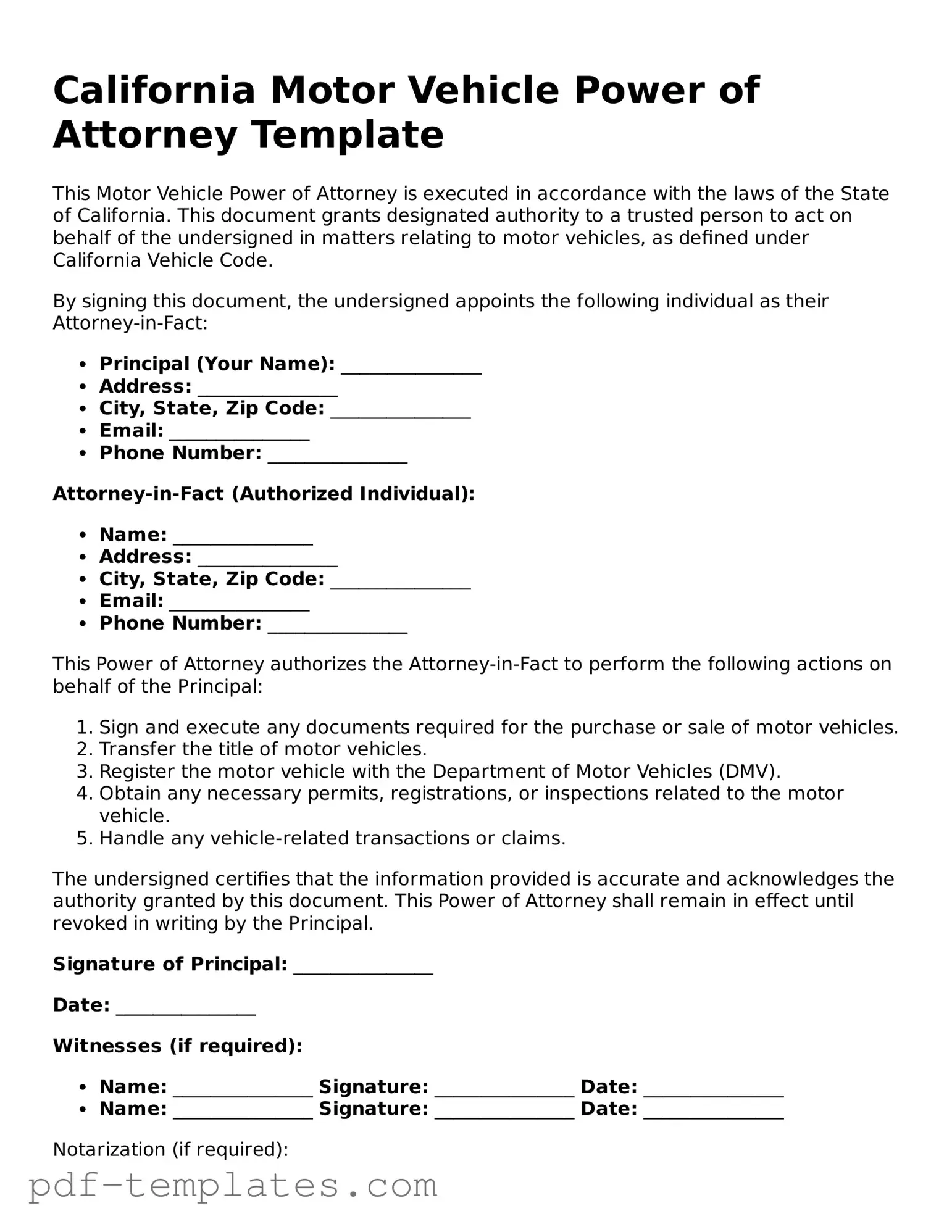The California Motor Vehicle Power of Attorney form is similar to a General Power of Attorney. Both documents allow one person to grant authority to another to act on their behalf. This can include handling various personal and financial matters. While the General Power of Attorney covers a broad range of activities, the Motor Vehicle Power of Attorney is specifically tailored to vehicle-related transactions, such as registering a car or transferring title.
When dealing with the various forms related to vehicle transactions, it is essential to understand not only their distinct functions but also the significance of a reliable framework of documentation. The California Notary Acknowledgement form plays a crucial role by ensuring signatures are verified and authenticated, reinforcing the legitimacy of the documents involved. For those seeking comprehensive resources, explore All California Forms that offer valuable templates and guidance essential for navigating these formalities effectively.
Another document that shares similarities is the Durable Power of Attorney. Like the Motor Vehicle Power of Attorney, this document allows someone to make decisions on behalf of another. The key difference lies in its durability; a Durable Power of Attorney remains effective even if the principal becomes incapacitated. This feature is particularly important for ongoing financial or healthcare decisions, while the Motor Vehicle Power of Attorney is typically limited to specific vehicle transactions.
A Limited Power of Attorney also resembles the Motor Vehicle Power of Attorney. Both documents grant specific powers to an agent for defined purposes. However, the Limited Power of Attorney can cover various areas beyond just vehicle transactions, such as real estate or financial matters. The specificity of the Motor Vehicle Power of Attorney makes it unique for automotive-related issues.
The Vehicle Title Application is another document that relates closely to the Motor Vehicle Power of Attorney. While the Power of Attorney allows someone to act on behalf of the vehicle owner, the Vehicle Title Application is the actual form used to register or transfer ownership of a vehicle. The Power of Attorney might be required to complete this application if the owner cannot be present.
Similarly, the Bill of Sale serves as a critical document in vehicle transactions. While the Motor Vehicle Power of Attorney enables someone to act on behalf of the vehicle owner, the Bill of Sale records the sale and transfer of ownership. Both documents are essential in ensuring that vehicle transactions are legally recognized and properly documented.
The Release of Liability form is another document that aligns with the Motor Vehicle Power of Attorney. This form is used to notify the Department of Motor Vehicles (DMV) that the seller is no longer responsible for the vehicle after it has been sold. While the Power of Attorney allows someone to handle the transaction, the Release of Liability ensures that the previous owner is protected from future liabilities associated with the vehicle.
The Application for Duplicate Title is also relevant. If a vehicle owner loses their title, they can use this application to obtain a duplicate. The Motor Vehicle Power of Attorney may be necessary if someone else is handling this process on behalf of the owner. Both documents facilitate the management of vehicle ownership and ensure that the necessary legal steps are taken.
The DMV Registration Renewal form shares a connection with the Motor Vehicle Power of Attorney as well. This form is used to renew a vehicle's registration, and if the owner cannot complete this task personally, the Power of Attorney allows another individual to handle the renewal process. Both documents ensure that vehicle ownership remains compliant with state regulations.
Finally, the Affidavit of Non-Ownership is a document that can be related to the Motor Vehicle Power of Attorney. This affidavit is used to declare that a person does not own a particular vehicle, often required in situations involving disputes or claims. While the Power of Attorney grants authority to act on behalf of a vehicle owner, the Affidavit of Non-Ownership serves to clarify ownership status in legal matters.
